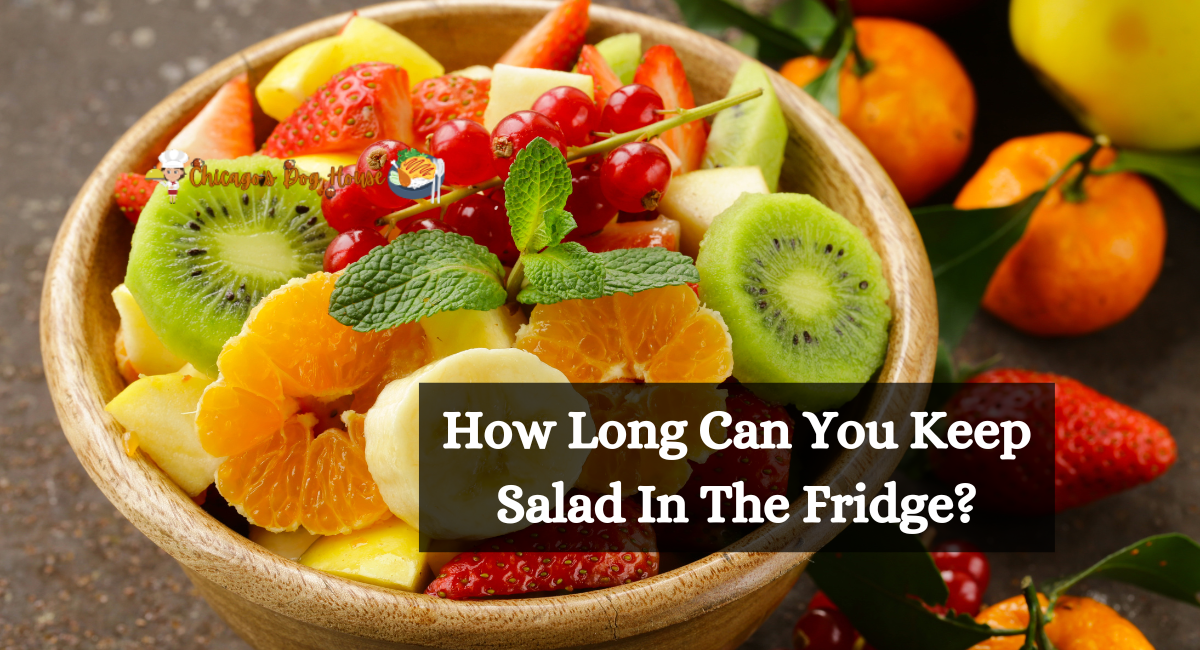Salad is one of the simplest and healthiest dishes to prepare. However, preparing salads and storing them in the refrigerator for an extended time is not advised. So, how long can you keep a salad in the fridge?
Some salads can rapidly spoil, even when stored in the refrigerator. But how long can salad be stored in the fridge? Last week, our team experimented, and here are the results.
How Long Can Salads Be Stored In The Refrigerator?
Salad is typically edible for 1-2 days after being opened. Based on our experiment, it can last up to five days in the refrigerator if appropriately stored.
If you have leftovers, place them in an airtight container or shrink wrap before placing them in the refrigerator.
It would be best if you refrigerated Packaged greens to maintain their freshness. They can be kept for five to six days. They must, however, be consumed within four days.
Factors To Consider
Types of salad
Here are the list of types of salad :
1. Tuna Salad
You can refrigerate tuna salad at 40 degrees Fahrenheit for three to five days before deterioration. Understanding the indicators of spoilage in tuna salad can prevent food-borne illness.
2. Green Salad
A green salad such as Caesar salad can be adequately stored for one week in the refrigerator without mayonnaise. With yogurt, you could refrigerate Caesar salad for up to two days.
3. Fruit Salad
Fruit salad could remain fresh for 3 to 5 days in the refrigerator. Mixing it with pears and avocados may cause it to turn brown quickly. Putting sugar could maintain its freshness for a week in the fridge.
4. Chicken Salad
You should chill the chicken salad for three to five days at 40 degrees or below for optimal quality.
5. Pasta-Based Salad
You can refrigerate Pasta salad for three to four days. The freshness of salads with oil-based condiments is preserved longer than those with mayonnaise.
6. Potato salad
Whether store-bought or homemade, potato salad is kept in the refrigerator for three to four days, if the salad has a printed expiration date, it should remain edible for an additional day or two.
7. Salad with Eggs
The egg salad can be consumed within four days if stored appropriately (in a sealed container in the refrigerator) and finished within that time frame.
8. Spring Salad
Spring blend salad greens perish more quickly than other varieties of greens. Please buy what you consume within 7 to 10 days and store it in the refrigerator. Mayonnaise must be divided.
9. Macaroni
When appropriately refrigerated, you will keep macaroni salad for three days in the refrigerator. Prepare the dish the night before for optimal flavor.
To avoid sogginess, you should include macaroni salad for at most two hours.
10. Quinoa
Quinoa can be refrigerated for five days. Check for odors, fungi, and milk liquid before removing food from the refrigerator.
Preparation Of Salad
Here are the some guidelines about preparation:
1. Without Dressing
Salads can be stored correctly in the refrigerator for up to 10 days without dressings. The lipids and water in the mayonnaise will not degrade the contents as it hydrates in the fridge.
2. With Dressing
Based on the preservation method and the mayonnaise, the salad’s shelf life is between 1 and 5 days. The salad’s shelf life may be brief if proper storage methods are not used.
3. With Excess Water
Extra liquid destroys salad. Green salad lasts longer than watery salad, which only lasts two days. On greens, a small quantity of water repels salad dressing oils, preventing leaf coverage.
4. Temperature
At 41°F, a salad containing dairy products and cheese will last five days.
It would help if you did not freeze Salads with kale, lettuce, and spinach to prevent wilted leaves.
How To Keep Salad In The Refrigerator?
Keeping salads fresh in the refrigerator requires separating the salad condiments. Invest in an airtight Tupperware as an alternative to applying dressing on your salad during food preparation or in the morning.
Keep your lettuce in resealable plastic containers. Wrapping salad greens in a dry paper towel aids in absorbing excess moisture that can cause rapid withering.
The glass preserves salad’s moisture better than plastic. Mason jars and Pyrex dishes with lids perform admirably.
How To Tell If It Has Gone Bad?
Here are some point to tell if it has gone bad:
1. Texture
If the salad has gone wrong, its texture will become gelatinous and slimy, and its components will emulsify. To avoid health hazards, do not consume.
2. Smell
A soured salad lost its pleasant aroma and was replaced by a foul one. If your salad scents like rotten eggs or your lettuce smells like dirt, do not consume them and dispose of them.
3. Tasty
When salad develops a harsh, sour flavor, it has gone rancid. If lettuce is bitter, you should not consume it. Throw it away immediately.
Always separate the mayonnaise to extend the shelf life of your salad.
Place dry paper towels on the vegetables after removing the lettuce from its packaging. In addition, you can use a salad spinner.
The paper towel will absorb moisture, extending the salad greens’ shelf life in the refrigerator.
How To Keep Salad Fresh And Make It Last Longer?
Salads are a go-to option for any occasion because they are crisp, fresh, and delectable. However, they paradoxically lose their freshness, crunchiness, and flavor quickly. Sometimes, purchasing salad ingredients can resemble a holiday weekend or your twenties. If you blink, you’ll miss it.
It doesn’t take long for the lush, verdant forest at the bottom of your refrigerator to become a shrine to Nickelodeon slime. However, there are methods to keep salad fresher longer and maintain its 15-minute fame.
Follow these ten tips to prevent food waste when preserving leafy greens:
1. Paper towel trekkers
Tossing in the towel takes on a whole new meaning when it comes to maintaining the freshness of salad. A gone-off salad is a slimy so-and-so, but adding a paper towel to your bag or container will absorb the moisture, prevent bacteria from spreading, and slow down decomposition.
2. Pie off the plastic
Plastic provides little protection for perishable foods. When you open a plastic bag, air and moisture accelerate the rapid decomposition.
We recommend purchasing plastic-free produce and preserving salad ingredients in alternative containers. However, more on this later!
3. Close it up
Sealable containers protect salad ingredients from air, moisture, and humidity. If you do not have a container, you can seal the bag with a clothespin, twine, or elastic band.
4. Dress for the occasion.
When preparing a salad, wait to add the vinaigrette until right before serving. Your salad will become soggy if you apply vinaigrette too soon, leading to regret. And nobody desires a soggy salad.
You may prepare your dish in advance but must store the vinaigrette in a separate container.
5. Stay on top of your toppings.
Dressings are only one of the items that you should keep separate until the final stage. Because avocados and apples can rapidly turn brown and mushy after slicing and dicing, you should not add them until just before serving.
Vegetables such as peppers, carrots, and cucumbers are more resilient and can be prepared a few days in advance.
6. Spin class
Anyone who has taken a spinning class knows you leave dehydrated and exhausted. The same holds for salad. Before storing your salad, spin it to eliminate damp spots and slime, thereby preventing the growth of pathogens.
7. Remove the spoilt brats.
If a few soggy leaves or brown stalks appear on your greens, there is no need to fret or discard the entire bunch. Simply toss the spoiled portions before they extend their sloppy, wilted arms across the stalks, stems, and leaves that are still fresh.
Have extra salad ingredients or leftovers? Avoid food waste by determining how to utilize cauliflower fronds and beetroot stalks.
8. Buy frozen
There is no shame in skipping the intermediary (the refrigerator) for frozen alternatives. Buying frozen berries and spinach allows you to use these ingredients at your leisure, as opposed to the customary race against rotting.
According to the British Heart Foundation, frozen fruits and vegetables are frozen immediately after harvesting, which helps to preserve their nutritional value until they are consumed.
9. Grow your fruit and vegetables.
Nothing is more fresh and ripe than selecting fruit and vegetables directly from the plant. Similarly to being on our eco-friendly milk round, you avoid plastic and annoying shopping excursions.
10. Store it correctly
Storage of salads can become a minefield. Sealable containers or nonsealable containers? Plastic or glass? Refrigerator or closet? These options affect the freshness and longevity of your salad.
However, you’ll soon be reaping the benefits of our below-described storage techniques when it comes to extending the shelf life of salads.
You can safely store a homemade salad in the refrigerator for three to five days. However, the exact lifespan depends on the ingredients used, their freshness, and appropriate storage in an airtight container. Regularly inspect for signs of withering or spoilage to ensure safety and quality.
Thank you for reading…..





